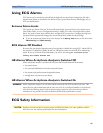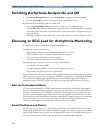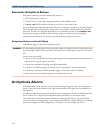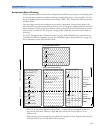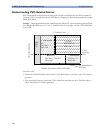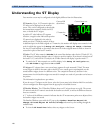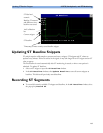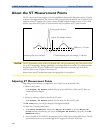
Arrhythmia Alarms 6 ECG, Arrhythmia, and ST Monitoring
113
Yellow Arrhythmia Alarms
Yellow arrhythmia alarms are short yellow alarms specific to arrhythmia-related patient conditions.
Depending on your monitor and Information Center revision, they may be shown with one or two
stars.
WARNING When arrhythmia analysis is on, all yellow alarms connected with ECG are short (one-star). This
means that the yellow alarm lamp and the tones are active for a configured number of seconds only,
after which the blinking numeric and the alarm message remain for up to three minutes. Red alarms
behave as usual.
Arrhythmia Alarms and Latching
When using arrhythmia analysis, Visual Latching and Audible Latching should be on
for red alarms, or at least Visual Latching should be on. Because of the transient nature of
arrhythmia alarms, many arrhythmia conditions may go unnoticed if alarm latching is off. This setting
can only be changed in Configuration Mode.
Switching Individual Arrhythmia Alarms On and Off
Some arrhythmia alarms can be individually switched on or off. They are:
Pacer not capture, Pacer not pace, Non-Sustain VT, Vent Rhythm, Run PVCs, Pair PVCs, R-on-T
PVCs, V.Bigeminy, V.Trigeminy, Multif.PVCs, Pause, SVT, Irregular HR, Missed Beat, PVCs/min.
♦ To switch individual alarms on or off, in the Setup Arrhythmia menu, select the alarm from
the list to toggle between
On and Off. The monitor displays the INOP message SOME ECG
ALRMS OFF.
Switching All Yellow Arrhythmia Alarms On or Off
All yellow arrhythmia alarms can be switched on and off together. To do this,
♦ In the Setup Arrhythmia menu, select All Yellow Off or All Yellow On.
Adjusting the Arrhythmia Alarm Limits
Some arrhythmia alarms have limits which can be individually adjusted. They are:
Vtach HR, Vtach Run, PVCs/min, Vent Rhythm, SVT HR, SVT Run, Asystole Thresh., Pause
Threshold.
1 To adjust alarm limits, in the Setup Arrhythmia menu, select the alarm to be adjusted.
2 Select the appropriate setting from the pop-up list.
Arrhythmia Alarm Timeout Periods
Normally, an arrhythmia alarm is announced when an alarm condition is detected. However, there are
certain situations that can inhibit the audible and visible indications of the alarm even though the
alarm condition was detected. These include:
• if a more serious alarm condition is active in the same chain
• if a timeout period is in effect for a particular alarm
• if a timeout period is in effect for a higher alarm in that chain.



